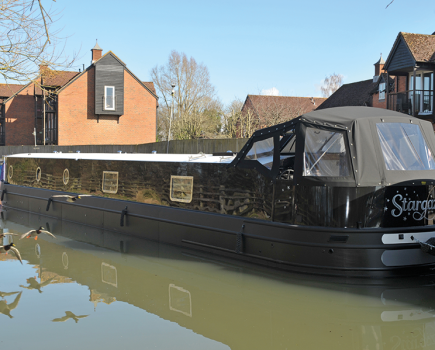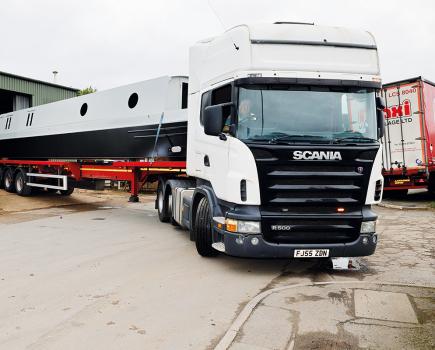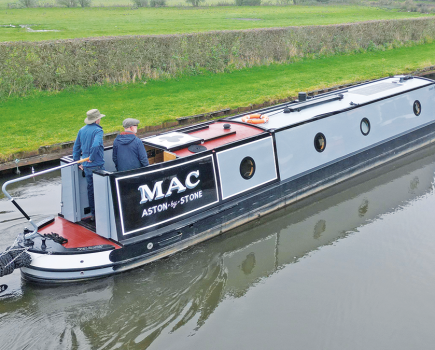If you had a chance to build a boat, then a second and then a third, how would you change things – Val and Graham did just that

There’s an oft-repeated saying that you only get your boat exactly right when you’re on your third one. It’s quite difficult to put this to the test, though, because most people don’t have three boats, especially from new.
But here’s a couple who have — and who immediately dispute the whole premise of the saying. According to Val and Graham Mattock, there was nothing really wrong with either of their previous two boats, it was just that as their circumstances changed, so did their requirements.
And that makes sense. When they had their first boat built back in 2003, finances were tight and they wanted a boat for weekends and holidays, so Shanorelle was a 52 footer. By the time of their second boat in 2009 they were looking at extended cruising with the possibility of living on board in the future. Shanorelle II was a 58ft trad (which, by the way, was the boat test in the April 2010 issue of Canal Boat, if you fancy rummaging through your back copies).
The liveaboard plan has come to fruition, so the couple’s latest boat, Hartland, is designed for that. It’s longer again at 60ft, has beefed up electrical and heating systems, and a bigger engine.
Inside, it’s similar to their previous boats (Graham refers charmingly to “the essence of Shanorelle”!) not least because they returned to the builder of both their previous boats for this one. Brayzel Narrowboats had served them well, and it’s a real vote of confidence that they’ve gone back to the firm again. Andrew Crook of Brayzel says he’s had a number of customers who’ve had two boats from him, but this is the first time he’s built a third!
Exterior
Hartland is a very good looking boat. The colour scheme is a classy mix of grey panels with black borders, which looks both traditional and contemporary. The traditional side is emphasised by having all portholes rather than windows, but the frames and all the other trim are in chrome which gives a more modern feel.

The steelwork is by Darren Barker of Cauldon Boats of Stoke-on-Trent. If that name sounds familiar, it might be because a few years ago Cauldon did some well received full fitouts; but Darren’s background was in steel fabrication, and he now concentrates on producing shells.
And this one looks good, with some very attractive lines. The bow is a pleasing shape and the boat sits nicely in the water. In addition, there’s some nice detailing, and the handrails have a useful finger grip on the inside.
This boat is a semi-trad — perhaps the biggest change from Shanorelle II, which was a trad. That boat had an extra large hatch so there was room for the couple to be together at the stern while travelling. But that meant Val had to stand up all the time, and she wanted somewhere to sit instead. So Hartland’s stern deck has lockers both sides; one is the gas locker, making changing a bottle much easier than having to balance on the nose. The Mattocks have added a pram cover over the semi-trad stern. These do nothing for the lines of any boat, but they do make the space much more useable — as somewhere to dry the dog after a walk, for example — and help keep the rear of the boat warmer in winter. At the bow, the well deck has built-in lockers on three sides, with cushions so they’re comfortable places to sit. The cross locker gives access to the bow thruster tube. With the gas locker at the stern, the space in the nose is available for storage; it stretches right down to the base plate, so there’s a false floor dividing up the space into really long term storage below, and things you need a bit more often above.
The water tank is under the well deck, and is made of stainless steel.
Layout and fitout
This is a reverse layout boat (the same as Shanorelle II) which works well with a semi-trad. The galley is at the stern, with a central walkway which then curves to the right to take you past an L-shaped dinette. This is another change from the previous boat, which had a Pullman style dinette. The saloon is in the middle of the boat.
A walk-through shower room comes next, with the cabin at the bow.

The fitout uses oak throughout. There are panels on the hull and cabin sides, with some lovely grain on show. All the trim and furniture is also oak — and Brayzel’s quality joinery shines through. All the doors are well made, all the joins are nice and tight, and all the screw heads are properly plugged.
The floor is engineered oak, except for the shower room where slate grey tiles have been used.
Galley
A set of ladder steps brings you down from the stern deck into the galley. On one side is the electrical cupboard containing the inverter and a range of controllers. Opposite is a drying cupboard with a radiator inside. The lower door of each cupboard lifts off, so they can be removed without having to move the steps.
This is a good sized galley — most of the boat’s extra two feet of length has been used here — and contains all the appliances you need as well as plenty of storage space. The cupboards have smart oak doors, there’s an extra-wide drawer for cutlery, and there are drawers in the kickspace at floor level. At the end of the shorter run of units, there’s a built in wine rack, and the under-gunwale space has been used for a can cupboard. There are more cupboards at high level, including one over the porthole above the hob, with doors shaped to match, providing a very handy space for cooking essentials such as spices and oils.
The worktops are a very attractive grey quartz, a composite material made from stone, which is far tougher than granite. There are tiny flecks which sparkle in the light, which is plentiful thanks to a Houdini hatch. Val says the pale colour is far easier to keep clean than the black granite in the previous boat, which showed up every water mark.
Appliances include an impressive Belling five burner hob (with a stainless steel splashback that reaches up the height of the cabin side), and a full size Belling oven. The Candy washer drier is also a full size model, and the fridge is a 240 volt Russell Hobbs. There’s a freezer hidden in the end of the dinette.

Dinette and saloon
The Mattocks’ last boat had a Pullman dinette, but this time they opted for an L-shape instead. They like the more open feel; it’s essentially an extension to the saloon. The dinette is raised to give a better view out, and there are drawers in the plinth. The seats themselves also offer plenty of storage space. The cushions are upholstered in an attractive grey tartan to reflect Val’s Scottish roots; there are extra loose covers, as Cheil the dog likes to sit up here.
The table is mounted on Desmo legs. The dinette converts into a bed by pulling out a frame and dropping the table down.
Opposite the dinette is the first of two sets of side doors. Both have a glass inner, which can either be dropped back to provide ventilation, or lifted out completely. There’s also a second Houdini hatch.
In the saloon proper, there’s a low-level tv unit which houses a box for the self-seeking satellite and a car radio, which has speakers built in. There’s also a surprising amount of storage space in this unit.
A Morso Squirrel stove sits on a hearth on one side of the door through to the shower room. The tiles are grey to match the colours used throughout the boat, while the flue is double-skinned. On the other side of the door is a unit in the style of a dresser. The solid doors of the lower part hide the access for the toilet cassette; there’s a useful charging point, as the sockets here have USB ports; the upper half of the dresser has glazed doors to make a display case.
There’s under gunwale LED lighting the length of the saloon and dinette, and two very smart double column radiators in anthracite grey. Graham and Val says they’re so good they stay hot for a couple of hours after the heating has gone off.

Shower room
A very spacious shower cubicle dominates this room — it’s a larger than normal quadrant at 910mm because of its bulbous design. It’s lined with a composite board rather than tiles. Between the cubicle and the hull side there’s room for a little bit of storage.
Across one corner is a large unit, topped with the same quartz as the galley with the basin inset. Along the base of the cupboard is LED lighting, switched on from the cabin to act as a night light. There’s enough light to show the way when you need a night-time visit to the loo, but not enough to wake up your other half.
On the other side of the room, sensibly hidden by the door when it’s open, is the Thetford cassette loo. It’s the model with a ceramic bowl — but without the usual high plastic back. It’s actually a model intended for motor homes, but chandlers can order it specially. It certainly looks more like a standard loo, which can only be a good thing.
Cabin
The door between the shower room and the cabin folds right back out of the way during the day.
There’s clearly been some discussion about the direction of the bed. Val and Graham’s first boat had a cross bed which Graham found rather short, so their second boat had an in-line one. Now they’ve gone back to a cross bed — but made it 5ft wide. Graham says it’s still a little short for him, but Val’s wish not to sleep alongside the cold wall of the boat during the winter apparently won out! The bed extends fairly simply, with a pull out frame, built in two halves, to support the mattress. The bed base has masses of storage space inside, mostly used for some folding chairs. The doors on the front of the base fold right back to make access easier.

Either side of the bed are very substantial wardrobes complete with internal lights, and drawers at the base. One has a tall dressing mirror on the inside of the door. There’s another wardrobe on the opposite side of the front doors, with shelves inside, and an impressive tall radiator on the outside.
The doors to the well deck are full steel rather than glazed, for extra security — and because the cabin is mostly used in the dark.
Technical
While the Mattocks’ previous boat was fairly straightforward technically, this time they’ve taken the decision to beef up virtually all the systems. That starts with the engine, which is a Beta 50 — bigger than you might usually find on a boat of this size. But the couple get about, and have done waters such as the tidal Thames and the Ribble Link, where a bit more power can be useful. The boat also has a bow thruster, a 75kgf unit by Vetus.
For the electrical system, there are five 110Ah Numax sealed batteries (plus another for the engine and two for the bow thruster). There are a couple of options for a 240 volt supply: first there’s a 3kw Victron inverter; but there’s also a 3.5kva Travel Power engine driven generator. An auto-changer has been fitted, which reverts back to the inverter when the Travel Power is switched off.
There are a couple of 120 watt solar panels on the roof, but an MPPT controller with spare capacity has been fitted, in case the couple decide to add to the solar array.
The heating system is also quite substantial, consisting of a Kabola diesel boiler. It’s a big unit, mounted in the engine hole; but Andrew Crook says that while some boilers are working at the upper end of their range in a narrowboat, this one could do a lot more. It means all the radiators through the boat can be double ones.

On the water
Graham is impressed by the handling of this boat, and you can see why. It goes where it’s pointed and turns very nicely, even in the somewhat blustery conditions of our test.
The engine is quiet, and there’s plenty of space for crew on the stern deck. One unusual feature is that the Morse control is mounted horizontally rather than vertically, due to the narrowness of the column it’s on. This means you push down for forward and pull up for reverse, which Graham says he’s quickly adapted to.
Verdict
This is a well equipped, comfortable boat which is well suited to living aboard. The price of a boat like this is £130,000 — perhaps a little more than the average Brayzel boat, because of the upgraded kit on board; the bigger engine, the Travel Power, and the Kabola boiler all add to the price.
Whether they’ve got this boat ‘right’ or not, Val and Graham insist that this will be their final new boat (although they said the same thing last time!). Either way, it demonstrates that lots of decisions aren’t really a matter of right or wrong. The important thing is getting them right for your current requirements — and that’s true whichever number boat you’re building.
The owners

Val and Graham Mattock both used to be police officers, so for many years boating was a great way of escaping the pressure. They hired for many years before buying that first boat of their own.
They get about, too, usually covering in excess of 800 miles and passing through at least 600 locks each year. Their previous boat had 3,800 hours on the clock after seven years.
While their previous boats had been named after a much loved dog, Hartland was chosen as a name for this one to honour Graham’s father. In the name panel are what look like a couple of pickaxes; they are in fact mattocks, implements which may have been used to dig canals. “We’re a couple of Mattocks”, says Graham, “so we thought we’d have a couple of mattocks on the side of our boat!”
Brayzel Narrowboats
Andrew Crook has been building boats since he left school, having enjoyed messing about in dinghies and cruisers as a child. He worked first for other people before deciding to set up on his own. Brayzel has been going since 1999, and has built well over sixty boats in that time. Recently, as well as full fitouts, he’s supplied sailways and partially fitted boats for customers to finish themselves, and has even done an office boat which is based in Manchester. Brayzel has a workshop at a marina on the Lancaster Canal.

Technical specifications
Length: 60ft
Beam: 6ft 10in
Shell: Cauldon Boats Tel: 07557 515145 www.cauldonboats.co.uk
Style: Semi-trad
Layout: Reverse
Berths: 2+2
Fit-out: Oak
Engine: Beta 50, Tel: 01452 723492 www.betamarine.co.uk
Inverter: Victron 3kw www.victronenergy.com
Bow Thruster: Vetus 75kgf www.vetus.com
Central heating boiler: Kabola Compact 7 www.kabola.co.uk £2,378
Radiators: Reina Neva www.heatandplumb.com £165 – £340 depending on size
Hob: Belling 5 burner GHU70GC www.currys.co.uk £200
Toilet: Thetford C260. Special order through Midland Chandlers www.midlandchandlers.co.uk £589
Total Price: £130,000
Brayzel Narrowboats
Bridge House Marina, Nateby Crossing Lane, Nateby, Preston, Lancashire PR3 0JJ
01995 601515. 07889 299731
brayzel@btopenworld.com
Image(s) provided by:
Archant







